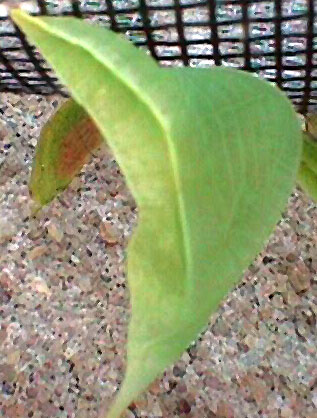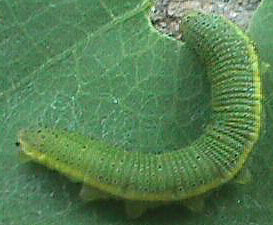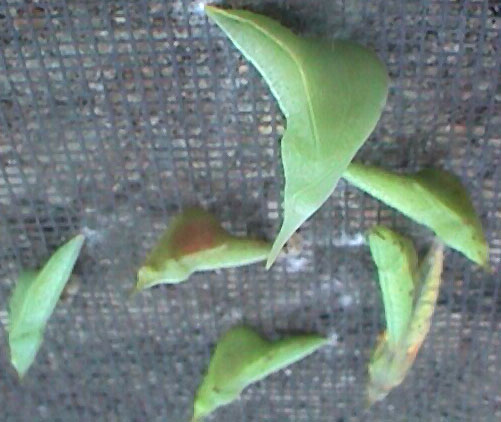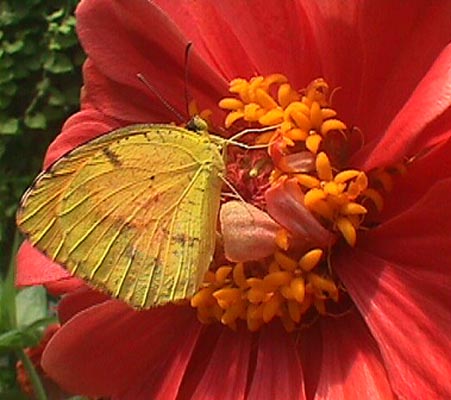SULPHURS: Phoebis, Colias, Eurema
There are many different kinds of Sulphur butterflies. I'm going to 'lump'
together all the Sulphurs in my garden. This is by no means all the species that
there are, just a very small list.
- ORANGE-BARRED SULPHUR - Phoebis philea
- Wing span is 2 3/4 - 4 inches. Upperside of male is bright yellow-orange; forwing
has a red-orange bar and hind wing has a red-orange outer margin. There are two
forms of the female, one is off-white and the other is yellow-orange. Female is much
larger than the male. Both have upperside of forwing with solid black cell spot and
submarginal row of broken, angled black smudges. Outer half of hindwing of yellow
form is red-orange.
- They are swift, high fliers. Females lay single eggs on leaves and flowers of host
plants (Cassia species in the pea family Fabaceae). Caterpillars
prefer to feed on the flowers. Butterflies nectar from many different flowers.
They prefer open lowland sites like gardens, forest edges, parks, and road edges.
- Range is from Brazil north to Florida. Irregular wanderers are seen in south
Texas; extremely rare vagrants are seen in Colorado, Minnesota, Wisconsin, and
Connecticut.
- CLOUDED SULPHUR - Colias philodice
- Wing span is 1 1/2 - 2 3/4 inches. Upper surface of male wings are bright, clear
yellow with solid black edging; lower side of forewing with some dark submarginal spots;
hindwing with silver cell spot rimmed with orange-pink, usually doubled. Female has
two forms: yellow form with uneven black edging enclosing yellow spots, and a white
form which is greenish-white rather than yellow. Spring and fall forms are smaller
and less conspicuously marked.
- Eggs are laid singly on host
plants (pea family Fabaceae, including alfalfa Medicago sativa, white
clover Trifolium
repens, and pea Pisum
sativum). Butterfly nectars from many flowers. They prefer open areas
including fields,
lawns, alfalfa and clover fields,
road edges and meadows.
- Range is from Alaska south thru central and southeast Canada, all of the the US, except
much of California, south Texas, and most of Florida.
- ORANGE SULPHUR - Colias eurytheme
- Wing span is 1 3/8 - 2 3/4 inches. Variable identification. Upperside of
male is yellow with orange overlay, yellow veins wide black border, and dark black cell
spot. Female is yellow or white white irregular black border surrounding light
spots. Underside hindwing spot silver with two concentric dark rings, and a spot
above it.
- Eggs are laid singly on top of
host plant leaves (pea family Fabaceae, including alfalfa Medicago sativa,
white clover
Trifolium repens, and pea Pisum
sativum). Young caterpillars chew holes in the tops of leaves, then later feed
from the leaf tip. Older
caterpillars eat half the leaf before moving to the other half. Chrysalids
overwinter. Butterflies
nectar from many kinds of flowers
including dandelion, milkweeds, goldenrods, and asters. They prefer open sites,
especially clover and alfalfa
fields, mowed fields, vacant lots, meadows, and road edges.
Range is from Southern Canada to
central Mexico, coast to coast in the US except for the Florida peninsula. This is
one of the most widespread and
common butterflies in North America.
- SOUTHERN DOGFACE - Zerene cesonia
- Wing span is 2 1/8 - 3 inches. Upperside forewings of both sexes have yellow
"dog's head" surrounded by black. "Eye" does not touch black
border. Female is similar, with duller, more diffuse black areas and two seasonal
forms: underside hindwing of wet season "summer" form is yellow; that of
dry season "winter" form is mottled with black and pink.
Eggs are laid on the undersides of terminal leaves of host plants ( small-leaved plants in
the pea family Fabacaea including alfalfa Medicago sativa, prairie
clovers Pentalostemon, indigo Dalea, and clover Trifolium).
Butterflies nectar from flowers such as alfalfa, coreopsis, houstonia, and verbena.
They prefer dry, open areas like short-grass prairie hills, scrub oak groves, open
woodland, washes, and road edges.
Range is from South America north to southern Texas and peninsular Florida. Stray or
temporary resident from central California northeast thru the Great Lakes area and all the
eastern states.
- CLOUDLESS SULPHUR - Phoebis sennae

 Wing span is 2 1/4 - 3 1/8 inches.
Upper surface of male is lemon yellow with no markings. Female is yellow or white;
outer edges of both wings with irregular black borders; upper forewing with dark spot in
cell. Lower surface of hindwing of both sexes with two pink-edged silver spots.
Wing span is 2 1/4 - 3 1/8 inches.
Upper surface of male is lemon yellow with no markings. Female is yellow or white;
outer edges of both wings with irregular black borders; upper forewing with dark spot in
cell. Lower surface of hindwing of both sexes with two pink-edged silver spots.
Eggs are laid singly on young leaves or flower buds of host plants (Cassia
species in the pea family Fabaceae). Caterpillars eat leaves and rest on
the underside of leaf petioles. Butterflies nectar from many different flowers with
long tubes including cordia, bougainvilla, cardinal flower, hibiscus, lantana, and wild
morning glory. They prefer disturbed open areas including parks, yards, gardens,
beaches, road edges, abandoned fields, and scrub.
Range is from Argentina north to southern Texas and the Deep South.- BARRED YELLOW - Eurema diara
- Wing span 1 1/4 - 1 5/8 inchs. Males and females differ; plus two seasonal forms.
Upperside of male forewing yellow with black bar along inner edge and a large balck
area at apex. Female varies from yellow to white; forewing with gray-black on apex
and black patch on outer edge of hindwing. Summer (wet season) form is smaller with
more extensive black areas. Underside hindwing of summer form is satiny white; that
of winter form is brick red or tan with two small black spots in cell.
Eggs are laid singly on the terminal growth of host plants (Pencil flower Stylosanthes
biflora, joint vetches Aeschynomene species, and other plants in the pea Fabaceae
family. Butterflies nectar from a great variety of flowers including joint
vetches and shepherd's needle Bidens pilosa. They prefer tropical and
subtropical dunes, pastures, and open pine woods.
Range is Argentina north to the US Deep South; stray into southern Arizona, South Dakota,
South Texas, and Washington, D.C.
- LITTLE YELLOW - Eurema lisa
- Wing span is 1 1/4 - 1 3/4 inches. Upperside of male forewing yellow with black
apex. Hindwing with black border. Female yellow or white (rare) with black
borders. Both sexes with small black spot on forwing cell.
Eggs are laid singly on midveins or between leaflets of host plant leaves (Partridge pea Cassia
fasciculata and wild sensitive plant C. nicitans, in the pea Fabaceae family).
Butterflies nectar from flowers in the aster family Asteraceae, including
goldenrods and asters. They prefer dry, open areas including roadsides, sandy
fields, ababdoned fields, along railroad tracks, and occasionally open woods.
Range is Costa Rica north to South Texas and the Deep South
- SLEEPY ORANGE -Eurema nicippe

 Wing span is 1 3/8 - 2 1/4 inches. Upperside of wings orange in both
sexes; orange-yellow form rare. Forewing with small black cell spot. Male with
sharply defined black borders on outer and costal margins; female borders not so
well-defined. In winter form, underside of hindwing is brick red, brown, or tan; in
summer form it's orange-yellow.
Wing span is 1 3/8 - 2 1/4 inches. Upperside of wings orange in both
sexes; orange-yellow form rare. Forewing with small black cell spot. Male with
sharply defined black borders on outer and costal margins; female borders not so
well-defined. In winter form, underside of hindwing is brick red, brown, or tan; in
summer form it's orange-yellow.
Eggs are laid singly under host plant leaves (Cassia species in the pea Fabaceae
family). Butterflies nectar on many species of flowers, including shepherd's needle Bidens
pilosa. They prefer low elevation areas including pine flats, fields, desert
scrub, gardens, vacant lots, road edges, and washes.
Range is Central America north ot along the US-Mexico border.
Thank you
to NPWRC, USGS, and Paul Opler, Ray Stanford, & Harry Pavulaan for their wonderful
site. Butterflies of North America is a much used butterfly database by many of my
'butterfly' friends around the country. The research from this page came
directly from their pages. Visit their site to see which butterflies are in YOUR
state. If you click on
checklist, you can see which butteflies are in your county.
 Back to the butterflies
Back to the butterflies
-
-
-
-
-

 Wing span is 2 1/4 - 3 1/8 inches.
Upper surface of male is lemon yellow with no markings. Female is yellow or white;
outer edges of both wings with irregular black borders; upper forewing with dark spot in
cell. Lower surface of hindwing of both sexes with two pink-edged silver spots.
Wing span is 2 1/4 - 3 1/8 inches.
Upper surface of male is lemon yellow with no markings. Female is yellow or white;
outer edges of both wings with irregular black borders; upper forewing with dark spot in
cell. Lower surface of hindwing of both sexes with two pink-edged silver spots.
 Wing span is 1 3/8 - 2 1/4 inches. Upperside of wings orange in both
sexes; orange-yellow form rare. Forewing with small black cell spot. Male with
sharply defined black borders on outer and costal margins; female borders not so
well-defined. In winter form, underside of hindwing is brick red, brown, or tan; in
summer form it's orange-yellow.
Wing span is 1 3/8 - 2 1/4 inches. Upperside of wings orange in both
sexes; orange-yellow form rare. Forewing with small black cell spot. Male with
sharply defined black borders on outer and costal margins; female borders not so
well-defined. In winter form, underside of hindwing is brick red, brown, or tan; in
summer form it's orange-yellow.